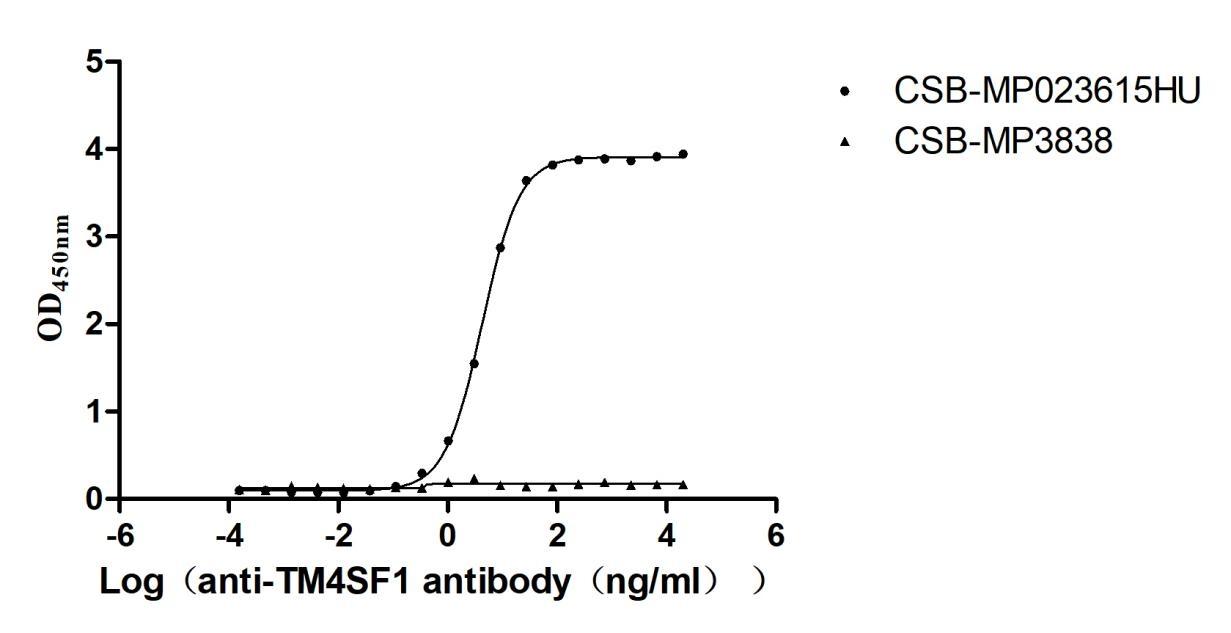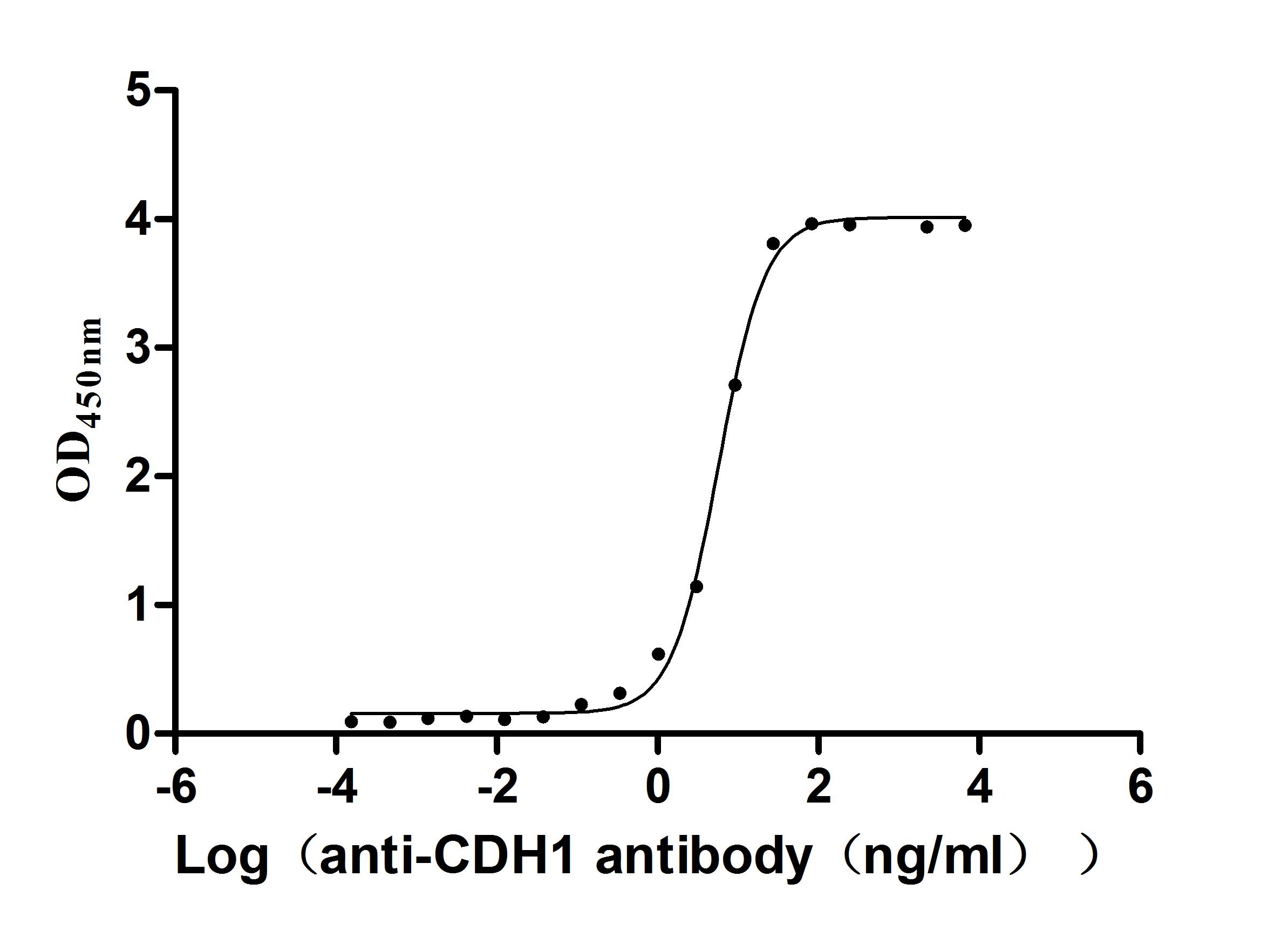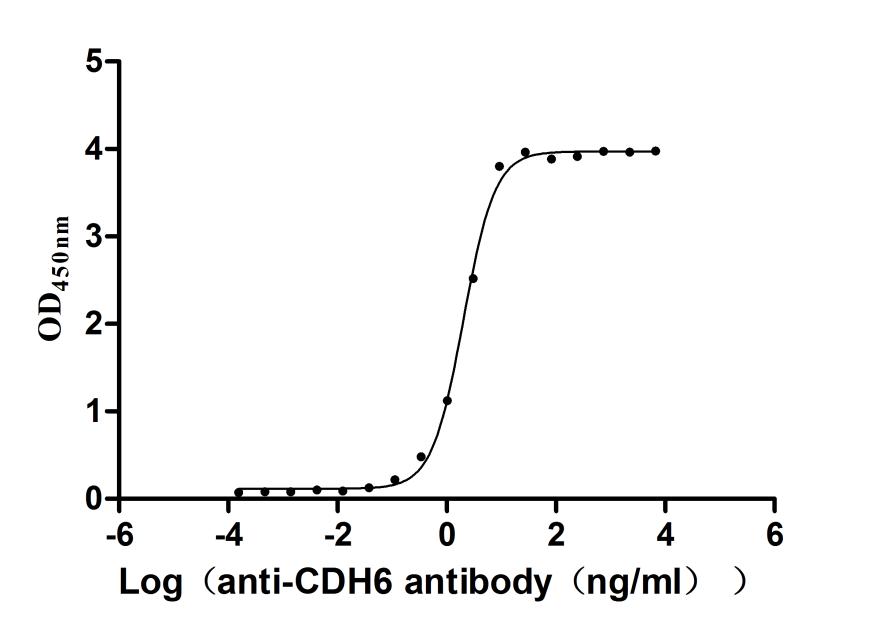Recombinant Human Granulins (GRN)
-
中文名稱:人GRN重組蛋白
-
貨號:CSB-YP009939HU
-
規格:
-
來源:Yeast
-
其他:
-
中文名稱:人GRN重組蛋白
-
貨號:CSB-EP009939HU
-
規格:
-
來源:E.coli
-
其他:
-
中文名稱:人GRN重組蛋白
-
貨號:CSB-EP009939HU-B
-
規格:
-
來源:E.coli
-
共軛:Avi-tag Biotinylated
E. coli biotin ligase (BirA) is highly specific in covalently attaching biotin to the 15 amino acid AviTag peptide. This recombinant protein was biotinylated in vivo by AviTag-BirA technology, which method is BriA catalyzes amide linkage between the biotin and the specific lysine of the AviTag.
-
其他:
-
中文名稱:人GRN重組蛋白
-
貨號:CSB-BP009939HU
-
規格:
-
來源:Baculovirus
-
其他:
-
中文名稱:人GRN重組蛋白
-
貨號:CSB-MP009939HU
-
規格:
-
來源:Mammalian cell
-
其他:
產品詳情
-
純度:>85% (SDS-PAGE)
-
基因名:
-
Uniprot No.:
-
別名:Acrogranin; CLN11; GEP; GP88; Granulin A; Granulin B; Granulin C; Granulin D; Granulin E; Granulin epithelin; Granulin F; Granulin G; Granulin-7; Granulins; GRN; GRN_HUMAN; PC cell derived growth factor; PCDGF; PEPI; PGRN; Proepithelin; Progranulin
-
種屬:Homo sapiens (Human)
-
表達區域:18-438aa
-
氨基酸序列TRCPDGQFCPVACCLDPGGASYSCCRPLLDKWPTTLSRHLGGPCQVDAHCSAGHSCIFTVSGTSSCCPFPEAVACGDGHHCCPRGFHCSADGRSCFQRSGNNSVGAIQCPDSQFECPDFSTCCVMVDGSWGCCPMPQASCCEDRVHCCPHGAFCDLVHTRCITPTGTHPLAKKLPAQRTNRAVALSSSVMCPDARSRCPDGSTCCELPSGKYGCCPMPNATCCSDHLHCCPQDTVCDLIQSKCLSKENATTDLLTKLPAHTVGDVKCDMEVSCPDGYTCCRLQSGAWGCCPFTQAVCCEDHIHCCPAGFTCDTQKGTCEQGPHQVPWMEKAPAHLSLPDPQALKRDVPCDNVSSCPSSDTCCRDNRQGWACCPYRQGVCCADRRHCCPAGFRCAARGTKCLRREAPRWDAPLRDPALRQLL
-
蛋白標簽:Tag?type?will?be?determined?during?the?manufacturing?process.
The tag type will be determined during production process. If you have specified tag type, please tell us and we will develop the specified tag preferentially. -
產品提供形式:Lyophilized powder
Note: We will preferentially ship the format that we have in stock, however, if you have any special requirement for the format, please remark your requirement when placing the order, we will prepare according to your demand. -
復溶:We recommend that this vial be briefly centrifuged prior to opening to bring the contents to the bottom. Please reconstitute protein in deionized sterile water to a concentration of 0.1-1.0 mg/mL.We recommend to add 5-50% of glycerol (final concentration) and aliquot for long-term storage at -20℃/-80℃. Our default final concentration of glycerol is 50%. Customers could use it as reference.
-
儲存條件:Store at -20°C/-80°C upon receipt, aliquoting is necessary for mutiple use. Avoid repeated freeze-thaw cycles.
-
保質期:The shelf life is related to many factors, storage state, buffer ingredients, storage temperature and the stability of the protein itself.
Generally, the shelf life of liquid form is 6 months at -20°C/-80°C. The shelf life of lyophilized form is 12 months at -20°C/-80°C. -
貨期:Delivery time may differ from different purchasing way or location, please kindly consult your local distributors for specific delivery time.Note: All of our proteins are default shipped with normal blue ice packs, if you request to ship with dry ice, please communicate with us in advance and extra fees will be charged.
-
注意事項:Repeated freezing and thawing is not recommended. Store working aliquots at 4°C for up to one week.
-
Datasheet :Please contact us to get it.
相關產品
靶點詳情
-
功能:Secreted protein that acts as a key regulator of lysosomal function and as a growth factor involved in inflammation, wound healing and cell proliferation. Regulates protein trafficking to lysosomes and, also the activity of lysosomal enzymes. Facilitates also the acidification of lysosomes, causing degradation of mature CTSD by CTSB. In addition, functions as wound-related growth factor that acts directly on dermal fibroblasts and endothelial cells to promote division, migration and the formation of capillary-like tubule structures. Also promotes epithelial cell proliferation by blocking TNF-mediated neutrophil activation preventing release of oxidants and proteases. Moreover, modulates inflammation in neurons by preserving neurons survival, axonal outgrowth and neuronal integrity.; Promotes proliferation of the epithelial cell line A431 in culture.; Inhibits epithelial cell proliferation and induces epithelial cells to secrete IL-8.; Stabilizes CTSD through interaction with CTSD leading to maintain its aspartic-type peptidase activity.
-
基因功能參考文獻:
- progranulin reduction might be the cause of multiple proteinopathies due to the accelerating accumulation of abnormal proteins including TDP-43 proteinopathy, tauopathy and alpha-synucleinopathy. PMID: 28473694
- Results suggest that serum PGRN levels are significantly higher in obese children in China and correlate significantly with obesity-related markers. Increased PGRN levels may be involved in the pathological mechanism of childhood obesity. PMID: 30151059
- Progranulin has a direct effect on tumor growth, migration, and invasion of human colon cancer cells. It may serve as a potential therapeutic target for human colon cancer. PMID: 30060789
- Accumulating evidence suggests that PGRN is essential for proper lysosomal function, but the precise mechanisms involved are not known. Here, we show that PGRN facilitates neuronal uptake and lysosomal delivery of prosaposin (PSAP), the precursor of saposin peptides that are essential for lysosomal glycosphingolipid degradation. PMID: 28541286
- miR-29b-3p bound to PGRN in a direct manner. Transfection with si-PGRN correlated with elevated E-cadherin expression, decreased snail and vimentin expressions, as well as less-motivated cell proliferation and cell metastasis. The H19/miR-29b-3p/PGRN axis modulated epithelial-mesenchymal transition of NSCLC cells via Wnt/beta-catenin signaling. PMID: 29754471
- SNPs in GRN are not related to ankylosing spondylitis susceptibility in a Chinese Han population. PMID: 29230494
- Plasma progranulin levels predict the presence of GRN null mutations independent of proximity to symptoms and brain atrophy. PMID: 29146050
- Serum progranulin may have potential to be used as a biomarker for the differentiation between early-onset pre-eclampsia and late-onset pre-eclampsia. PMID: 28574293
- CHI3L1 may be a previously unrecognized biomarker for diagnosing Gaucher Diseases (GD) and for evaluating the therapeutic effects of new GD drug. PMID: 29396296
- The increased serum progranulin concentrations were closely related to measures of adiposity, metabolic parameters, inflammatory marker and insulin resistance indices, suggesting that progranulin may be an excellent biomarker for obesity in childhood. PMID: 29176029
- This work identifies PGRN as an activator of lysosomal cathepsin D activity, and suggests that decreased cathepsin D activity due to loss of PGRN contributes to both FTD and NCL pathology in a dose-dependent manner. PMID: 29036611
- MiR-29b-3p promotes chondrocyte apoptosis and facilitates the occurrence and development of osteoarthritis by targeting PGRN. PMID: 28609022
- Results provide evidence that progranulin destabilizes sortilin via ubiquitination and lysosomal degradation to override the negative modulatory functions of sortilin thereby assuring the sustainable pro-tumorigenic actions of progranulin in castration-resistant prostate cancer. PMID: 28433812
- PGRN is a regulator of tumorigenesis because it stimulates cell proliferation, migration, invasion, angiogenesis, malignant transformation, resistance to anticancer drugs, and immune evasion. [review] PMID: 29116422
- PGRN regulated its own expression in a positive feedback loop via the AKT and ERK signaling pathways. PMID: 29039535
- PGRN is involved in lysosomal homeostasis and lipid metabolism. PMID: 28903038
- High serum GP88 concentrations are associated with poor prognosis in patients with DLBCL PMID: 28823651
- This study showed that endogenous levels of multiple GRNs are haploinsufficient in FTD-GRN patient fibroblasts and frontal cortex, mirroring full-length PGRN. PMID: 28828399
- HSPA5 (GRP78) and GEP were identified to interact. Clinical analysis showed that expression of GRP78 was up-regulated in hepatocellular carcinoma tumor and correlated with GEP expression. PMID: 28601093
- the expression of PGRN was significantly upregulated in Osteonecrosis of the Femoral Head patients' articular cartilage, and recombinant PGRN could promote expression of aggrecan and collagen II and the activation of ERK1/2. PMID: 28247166
- White matter hyperintensities are seen only in GRN mutation carriers in fronto-temporal dementia. PMID: 28529873
- The study provides solid evidence that there is the interaction between GRN A and ENO1 and the interaction is responsible for the effects of GRN A on glucose uptake as well as cancer cell migration and invasion. PMID: 28415822
- This study ascertained that PGRN expression in airway epithelial cells inhibits CS-induced apoptosis, presumably through regulation of the ER stress response and MAPK activation. PMID: 28273689
- This study describe a novel GRN, p.(Tyr229*) mutation, resulting in haploinsufficiency of GRN and a severe neuropathologic FTLD phenotype. PMID: 27767988
- This meta-analysis supported the T allele of rs5848 within progranulin, as a risk factor for Alzheimer's Disease. PMID: 26820675
- Our case report further corroborates the notion that, in addition to FTD, progranulin may be involved in the neurobiology of bipolar disorder type 1, and suggests to screen patients with late-onset bipolar disorder for GRN mutations. PMID: 28664756
- GRN SNPs likely influence disease course and relapse recovery in multiple sclerosis. PMID: 26447062
- This study revealed no patients presenting with typical clinical PSPS to have evidence of GRN mutations producing TDP-43 pathology. PMID: 27163816
- This study reported a novel pathogenic splice site mutation in GRN (c.709-2 A>T) causative for FTD and we show that 1) GRN LoF mutations are a rare cause of FTD in this Italian cohort. PMID: 27258413
- progranulin expression is critical for tumor growth in vivo, in both xenograft and orthotopic tumor models PMID: 27220888
- results revealed an important role of NF-kappaB signalling in PGRN-associated frontotemporal lobar degeneration-DNA-binding protein 43 and confirm that PGRN can bind to TNF-alpha receptors regulating the expression of WNT5A, suggesting novel targets for treatment of frontotemporal lobar degeneration-DNA-binding protein linked to GRN mutations. PMID: 26624524
- These results suggest an important role of Wnt activation inducing cell cycle disturbance-mediated neuronal loss in the pathogenesis of PGRN deficiency-linked frontotemporal lobar degeneration with TDP-43 protein inclusions. PMID: 26676574
- Study demonstrate that PGRN interacts with the lysosomal protease CTSD and maintains its proper activity in vivo. Therefore, by regulating CTSD activity, PGRN may modulate protein homeostasis. This could potentially explain the TDP-43 aggregation observed in frontotemporal lobar degeneration with GRN mutations. PMID: 28493053
- Data indicate significant correlation of granulin-epithelin precursor (GEP) with beta-catenin in hepatocellular carcinoma (HCC) cohort. PMID: 26942873
- We identified 3 novel GRN mutations (p.Q130X, p.317Afs*12, and p.K259Afs*23) in patients diagnosed with nonfluent-variant PPA or behavioral-variant FTD. The frequency of GRN mutations was 9.6% and that of MAPT mutations was 7.1%. Among familial cases of FTD, the frequency of GRN mutations was 31.5% and that of MAPT mutations was 10.5% in Brazil. PMID: 27082848
- Missense mutation in GRN gene affecting RNA splicing and plasma progranulin level in a family affected by frontotemporal lobar degeneration. PMID: 28285794
- existence of a founder effect for C157KfsX97 mutation in patients with frontotemporal lobar degeneration inSouthern Italy. PMID: 27814992
- GRN gene deletion is genetic etiology of familial frontotemporal dementia. PMID: 28153380
- Thisstudy has demonstrated the effect of inflammatory cytokine on cartilage graft as well as the protective role of PGRN on this graft. Without the anti-inflammatory effect from PGRN, hyaline cartilaginous extracellular matrices in living hyaline cartilage graft constructs could be easily remodeled into fibrotic or mineralized tissue and would no longer be able to fulfil the role of a cartilage graft. PMID: 27465877
- This study demonstrated that the GRN mutation carriers showed significant frontoparietal hypoperfusion compared with controls at follow-up. PMID: 27625986
- The GRN risk SNP (rs5848) was associated with variation in detected levels of CSF proteins previously implicated in CNS inflammation. The same GRN risk allele was also associated with increased CSF tau which may indicate directly related neurodegenerative changes. PMID: 28189700
- Granulin is deposited in specific brain regions that differ between Alzheimer's disease patients and Frontotemporal lobar degeneration patients. PMID: 29044416
- Mutation of GRN is a common cause of FTD in mainland China. PMID: 27311648
- the influence of the p.A152T MAPT variant on the clinical and neuropathological features of these Basque GRN families, is reported. PMID: 28594853
- Results indicate that central nervous progranulin reduction is not restricted to the relatively rare cases of frontotemporal dementia caused by progranulin gene (GRN) loss of function mutations, but also contributes to the more common GRN-negative forms of frontotemporal dementia. PMID: 27760429
- a complete screening for mutations in MAPT, GRN and C9ORF72 genes revealed a frequency of 5.4% of pathogenic mutations in a random cohort of 93 Turkish index patients with dementia PMID: 27632209
- This Progress article reviews recent advances in progranulin biology emphasizing its roles in lysosomal function and brain innate immunity, and outlines future avenues of investigation that may lead to new therapeutic approaches for neurodegeneration--{REVIEW} PMID: 28435163
- serum progranulin levels had a positive correlation with pulmonary function in patients with asthma and a negative correlation with blood neutrophil counts. PMID: 28073702
- Progranulin (PGRN), a 593-amino-acid autocrine growth factor has multiple functions involved in cell proliferation, wound healing, neurodegeneration, insulin resistance, and tumorigenesis. PMID: 27149013
- progranulin is affected by a decrease in eGFR, being at a higher concentration in serum and lower in urine of DKD patients with T2DM and eGFR <60 mL/min/1.73m2. It is also associated with markers of obesity and inflammation PMID: 27776152
顯示更多
收起更多
-
相關疾?。?/div>Ubiquitin-positive frontotemporal dementia (UP-FTD); Ceroid lipofuscinosis, neuronal, 11 (CLN11)亞細胞定位:Secreted. Lysosome.蛋白家族:Granulin family組織特異性:In myelogenous leukemic cell lines of promonocytic, promyelocytic, and proerythroid lineage, in fibroblasts, and very strongly in epithelial cell lines. Present in inflammatory cells and bone marrow. Highest levels in kidney.數據庫鏈接:
Most popular with customers
-
Recombinant Human CD226 antigen (CD226), partial (Active)
Express system: Mammalian cell
Species: Homo sapiens (Human)
-
Recombinant Human Tumor necrosis factor receptor superfamily member 11B (TNFRSF11B) (Active)
Express system: Mammalian cell
Species: Homo sapiens (Human)
-
Recombinant Human Poliovirus receptor (PVR) (I340M), partial (Active)
Express system: Mammalian cell
Species: Homo sapiens (Human)
-
Recombinant Human Transmembrane 4 L6 family member 1(TM4SF1)-VLPs (Active)
Express system: Mammalian cell
Species: Homo sapiens (Human)
-
Recombinant Human Cadherin-1(CDH1),partial (Active)
Express system: Mammalian cell
Species: Homo sapiens (Human)
-
Recombinant Mouse Cadherin-6(Cdh6),partial (Active)
Express system: Mammalian cell
Species: Mus musculus (Mouse)


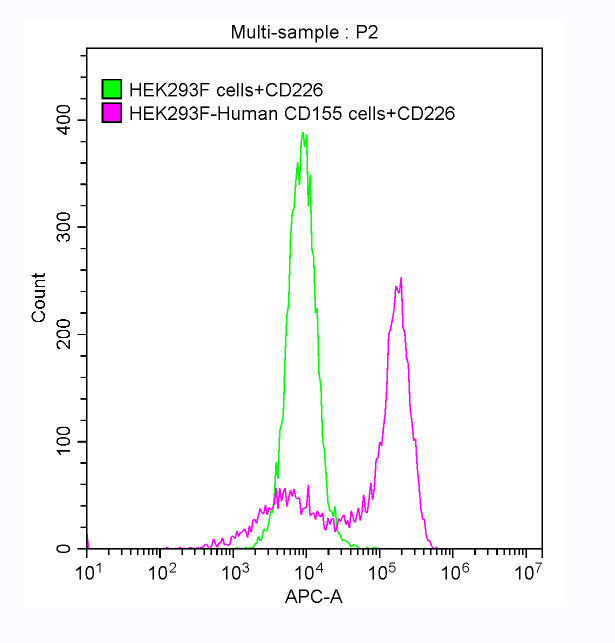
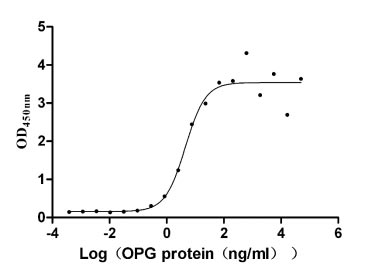
-AC1.jpg)
